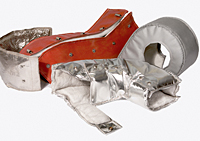Essentially, it comes down to some key factors including the need for removability, your space constraints, the importance of fireproofing, and finally, cost.
Type of Insulation:
An important factor is the type of insulation needed, including the desired strength. Considering that Firwin HC™ is in fact hard and more durable, it is more suited for extremely rugged conditions. Our blankets, although also tough, are not as impenetrable as our hard coatings. The hard coat is more applicable where there is a possibility of sharp objects coming into contact with the insulation and the possibility where insulation can be torn.
Removability:
Firwin HC™ Hard Coat is permanently applied and cannot be removed, while our insulation blankets can in fact be removed and even reused. This is important if you need to do periodic maintenance on whatever you are insulating. In that case, the blankets will better serve your needs. Additionally, since the hard coating is applied directly onto parts, you need to disassemble you components and send them to Firwin for coating. If the components are difficult to access and disassemble, then we recommend using our insulation blankets.
Space Constraints and Fireproofing:
Because Firwin HC™ is applied directly to the component, it conforms tightly to the part and is ideal for applications that offer limited space. The thinness and flexibility of the hard coating makes it more of a viable option when the blankets are too bulky to fit.
Firwin HC™ is non-flammable and proves to be a valuable safety and fireproof option. As for the insulation blankets, they are fire retardant. For those applications requiring a further measure of safety, Firwin offers our MineWrap™ blankets which completely enclose and prevent any oils or fluids from lodging in the insulation and igniting fire.
Cost:
While both insulations take about 2-3 weeks in lead time from order to delivery, hard coating will last longer but are also more than removable insulation.
Therefore, whether you need hard coat or removable insulation, there is one thing you can count on, and that’s the experts at Firwin. If you have any doubts about which is right for you, just contact a rep at Firwin today and we can help you make the perfect insulation decision.
 |
| Firwin insulation blankets |
 |
| Firwin HC™ Hard Coat |













